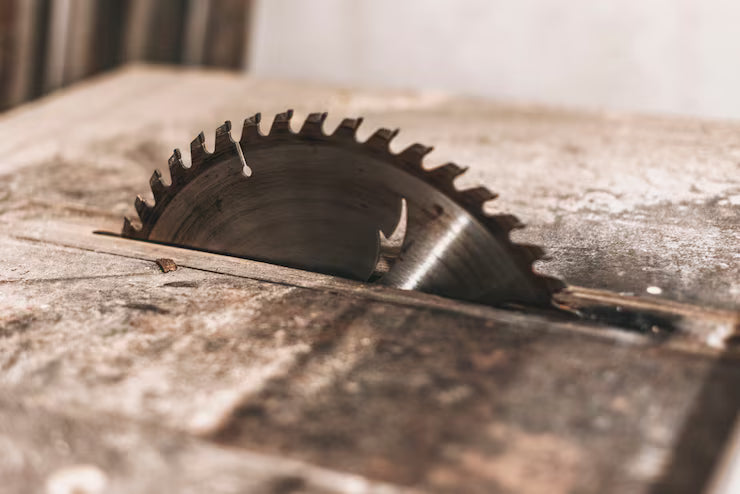Saw Blades
Saw Blade Mastery: The Ultimate Guide for South African Projects

Whether you're cutting wood, metal, masonry, or plastics, the right saw blade turns good work into great craftsmanship. Understanding blade anatomy, compatibility, and maintenance ensures efficiency, precision, and safety.
Saw Blade Anatomy 101
To choose the ideal blade, we need to understand what makes it tick:
- Tooth Count: More teeth = smoother cut; fewer teeth = faster rough cuts.
- Tooth Shape: Determines cutting aggressiveness and finish quality.
- Gullet: The space between teeth clears debris—larger gullets suit softer materials.
- Kerf: Blade thickness affects material waste and accuracy.
- Blade Material: Steel, carbide-tipped, or diamond determines cutting capability and lifespan.
Understanding blade geometry allows us to match each blade to task and material.
Material-Specific Blade Matching
| Material | Ideal Blade Type | Tips |
|---|---|---|
| Wood | Large-tooth carbide-tipped | Use crosscut for smooth edges, rip for speed |
| Metal | Fine-tooth steel or carbide-tipped | Slower feed rate; use lubricant |
| Plastic | High-tooth count, fine-toothed | Minimize friction to prevent melting |
| Masonry | Abrasive or diamond-tipped | Use water cooling for longer life |
Circular Saw Blades
Circular saws offer unmatched versatility. Their blades vary widely based on task:
- Rip Blades: For fast, straight cuts along wood grain.
- Crosscut Blades: Deliver smooth cuts across grain.
- Combination Blades: Tackle both crosscut and rip tasks.
- Specialty Blades: Include abrasive edges for metal or concrete.
Always confirm blade diameter and arbor compatibility with your tool.
Table Saw Blades
Precision woodworking demands smart blade choices:
- Crosscut Blades: 60–80 teeth for smooth finishes.
- Rip Blades: 24–30 teeth for quick stock trimming.
- Dado Sets: For groove cutting in cabinetry.
- Fine Finish Blades: High tooth count ideal for veneers and laminates.
Carbide-tipped blades maintain sharpness longer—great for repeat jobs.
Jigsaw & Reciprocating Saw Blades
Jigsaw Blades:
- Designed for detailed or curved cuts.
- Best used in wood, plastic, soft metals.
- Choose blade type based on TPI (teeth per inch).
Reciprocating Saw Blades:
- Ideal for demolition, plumbing, or rough work.
- Available in wood, metal, multi-material configurations.
- Look for aggressive tooth design for fast results.
Specialty Blades
When a standard blade won't cut it—literally:
- Diamond Blades: For ceramic, tile, concrete.
- Carbide-Grit Blades: Handle abrasive materials like fiber cement.
- Non-Ferrous Metal Blades: Tailored for aluminum or copper.
- Laminate Blades: Reduce chipping and deliver clean edges.
Specialized tasks deserve specialized tools.
Tooth Count & Performance Impact
| Tooth Count | Cut Quality | Ideal Use Case |
|---|---|---|
| 18–30 | Fast, rough | Framing, demolition |
| 40–60 | Moderate | General purpose woodworking |
| 80+ | Fine finish | Cabinetry, veneered surfaces |
Blade Materials & Coatings
| Blade Material | Pros | Use Case |
|---|---|---|
| Steel | Affordable, flexible | Occasional DIY tasks |
| Carbide-Tipped | Long-lasting, high performance | Frequent pro-level cutting |
| Diamond-Coated | Extreme durability | Masonry, tile, concrete |
Coatings such as titanium or Teflon reduce friction, resist pitch buildup, and prevent overheating.
Blade Care & Maintenance
Proper upkeep boosts both performance and safety:
- Clean blades with blade-safe solvents to remove resin/pitch
- Sharpen regularly—either professionally or using DIY kits
- Store in racks or cases to avoid warping and dulling
- Avoid moisture to prevent corrosion
Safety Practices
- Disconnect power when changing blades
- Always wear gloves, eye protection, and hearing protection
- Follow manufacturer torque specs when tightening blades
- Never force a blade through material—it can kick back or break
Frequently Asked Questions
Can I Use One Blade Across Different Tools?
Blades are typically tool-specific. Some may cross over with adapters, but most circular, table, and reciprocating saws need blades tailored to their motion and arbor design.
How Should I Store My Saw Blades?
Use vertical wall racks, blade bags, or cases. Keep blades dry, separated by type, and away from sharp impacts or direct sunlight.
What Should I Consider When Buying a Blade?
- Match blade to material
- Choose based on tooth count & finish
- Consider frequency of use
- Don't overlook coating and durability
Final Remarks
Think of your saw blades as the handshake between tool and task. The more thoughtfully you choose, maintain, and use them, the more refined your craftsmanship becomes. Whether you’re building furniture, renovating your home, or working on-site, the perfect blade doesn’t just cut—it creates.




